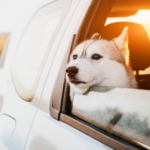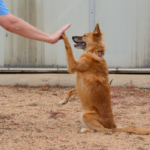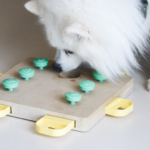Introduction
Capturing your dog’s unique personality through photography is a delightful way to immortalize the joy they bring into your life. This article aims to guide pet owners in creating stunning pup portraits, celebrating the essence of their furry companions. From understanding dog photography basics to navigating challenges, let’s embark on a journey to frame your pup’s personality.
Mastering Dog Photography Basics
Embarking on the journey of pup photography requires a solid foundation in the basics of photography. Mastering the fundamentals, such as lighting, composition, and angles, serves as the key to creating captivating and memorable dog portraits.
Lighting plays a pivotal role in photography, and when it comes to capturing your furry friend, it’s crucial to harness natural light effectively. Opt for soft, diffused lighting during the golden hours – sunrise and sunset – to achieve warm, flattering tones and gentle shadows. Avoid harsh midday sun, as it can create unappealing highlights and shadows.
Composition is another essential aspect of crafting engaging pup portraits. Experiment with the rule of thirds, placing your dog off-center for a visually pleasing and balanced image. Consider the background – opt for clean, uncluttered spaces that won’t distract from your canine subject. Be mindful of your dog’s surroundings to enhance the overall composition.
Angles add depth and uniqueness to your pup portraits. Get down to your dog’s eye level to create an intimate connection and capture the world from their perspective. Experiment with different viewpoints – whether shooting from above for a whimsical feel or from below to highlight your dog’s stature.
Experimenting with camera settings is crucial for achieving the desired effects. Understand the basics of your camera, adjusting aperture, shutter speed, and ISO to control exposure. A wider aperture (lower f-stop) creates a shallow depth of field, keeping your dog in focus while blurring the background for a professional look.
Choosing the Right Equipment
Selecting the appropriate equipment is a crucial step in capturing the perfect moments with your furry friend. Whether you’re using a camera, smartphone, or a specialized pet camera, each option comes with its own set of considerations.
Cameras offer a range of features, making them a popular choice for serious pet photographers. DSLRs provide manual controls for adjusting settings, ensuring optimal results in various conditions. Mirrorless cameras offer similar capabilities in a more compact design. When dealing with active dogs, these cameras allow for quick autofocus and burst mode to capture those playful moments effortlessly.
Smartphones have become powerful tools for everyday photography, and they’re often the most convenient choice when spontaneous moments arise. Modern smartphones boast impressive cameras with advanced features like portrait mode and low-light capabilities. However, their limitations may become apparent when dealing with fast-moving pets. To overcome this, use burst mode or dedicated pet photography apps that enhance focus and shutter speed.
Dedicated pet cameras are designed specifically for capturing moments with your four-legged friend. These devices often include features like treat dispensers, allowing you to capture your pet’s attention for the perfect shot. They can be especially useful for shy or camera-wary pups, providing a less intimidating and more familiar approach to photography.
Addressing challenges specific to each scenario is essential. For active dogs, ensure your equipment can keep up with quick movements by using fast shutter speeds and continuous autofocus. Shy or easily distracted pups may benefit from using treats or toys to grab their attention, creating a more engaging and positive experience.
Setting the Scene
Creating the perfect environment is key to capturing your dog’s authentic personality in photographs. Dogs, like people, have preferences and comfort zones, and understanding these factors is crucial for setting the scene for a successful photoshoot.
Potential issues may arise from distractions or discomfort that can make it challenging for your dog to be themselves during the photoshoot. To address distractions, choose a location that is familiar to your dog and minimizes external stimuli. This could be your backyard, a quiet park, or any space where your dog feels at ease. Familiar settings help your dog stay focused on you and the camera, resulting in more natural and expressive photographs.
Discomfort can arise from various factors such as unfamiliar sounds, textures, or even weather conditions. To overcome this, bring along your dog’s favorite toys, blankets, or treats. These familiar items provide a sense of security and comfort, making the environment more enjoyable for your furry friend. If you’re shooting outdoors, consider the weather and choose a time when it’s not too hot or cold, ensuring your dog is comfortable throughout the session.
Understanding your dog’s personality is crucial for setting the right scene. Some dogs love exploring new places, while others may prefer the familiarity of home. Tailor the environment to suit your dog’s preferences, whether it’s a quiet indoor setting or an adventurous outdoor space. This will make the photoshoot a positive experience for your dog, resulting in more natural and genuine expressions.
Building a Connection
Building a strong connection with your dog is essential for capturing genuine and heartwarming moments in your photos. However, challenges such as anxiety or restlessness can hinder the process. Here are some tips to overcome these obstacles and foster a relaxed atmosphere for authentic expressions.
- Prioritize Comfort: Ensure your dog is comfortable with the surroundings, equipment, and any accessories you plan to use. Familiarize them with the camera by letting them sniff and investigate it before starting the photoshoot. Use positive reinforcement, like treats or praise, to associate the camera with positive experiences.
- Practice Patience: Dogs, like people, may feel anxious in unfamiliar situations. Allow your dog time to acclimate to the environment before expecting them to pose. Start with short sessions and gradually increase the duration as your dog becomes more comfortable. Patience is key to building trust and a strong bond.
- Bring a Helper: Enlist the assistance of a friend or family member to help manage your dog during the photoshoot. Having an extra set of hands can be invaluable for keeping your dog engaged, holding props, or providing comfort if needed. This allows you to focus on capturing the perfect shots.
- Incorporate Play: Turn the photoshoot into a playful and enjoyable experience for your dog. Bring their favorite toys or engage in activities they love. Playful interactions can lead to candid and authentic expressions, showcasing your dog’s personality in the photos.
- Choose the Right Time: Schedule the photoshoot at a time when your dog is naturally more relaxed. Consider their daily routine, and select a time when they’ve had some exercise and are neither too energetic nor too tired. A content and well-exercised dog is more likely to cooperate during the session.
- Create a Safe Zone: If shooting in an open area, set up a familiar and secure space where your dog can retreat if they feel overwhelmed. This can be a blanket or bed that they associate with comfort. Having a designated safe zone provides a sense of security and reduces anxiety.
Editing Techniques
Editing plays a crucial role in refining and perfecting your pup portraits, elevating them from good to exceptional. However, it’s essential to approach editing with a delicate touch, ensuring that your dog’s natural features shine through without compromising authenticity. Here are some techniques to enhance your pup portraits while avoiding common pitfalls:
- Start with Good Lighting: Before diving into editing, ensure that your original photo has optimal lighting. Well-lit photos provide a solid foundation for editing and help retain the natural colors and textures of your dog’s fur. Adjust exposure and brightness as needed before applying further edits.
- Use Non-Destructive Editing: Opt for non-destructive editing techniques to maintain the integrity of your original photo. This allows you to experiment with adjustments without permanently altering the image. Many photo editing tools offer features like adjustment layers or virtual copies for non-destructive editing.
- Enhance Colors Naturally: If you choose to adjust colors, do so subtly to maintain a natural look. Avoid oversaturating or drastically changing your dog’s coat color. The goal is to enhance the existing tones rather than create an artificial appearance. Pay attention to the balance of colors in the overall image.
- Focus on Sharpness and Clarity: Sharpening your image can bring out the details in your dog’s fur and eyes. Use the sharpening tool with caution, applying it selectively to avoid introducing noise or artifacts. Adjusting clarity can add depth to the photo, but moderation is key to prevent an overly processed look.
- Remove Distractions: If there are distracting elements in the background, use editing tools to remove or blur them. This helps direct the viewer’s focus to your dog and creates a cleaner, more polished image. Be mindful not to overdo it, ensuring the final result looks seamless.
- Retain Natural Textures: Preserve the authentic textures of your dog’s fur by avoiding excessive smoothing or blurring. Embrace the natural variations and patterns, as these contribute to the uniqueness of your pup’s appearance.
- Crop Thoughtfully: If cropping is necessary, do so thoughtfully to maintain a balanced composition. Consider the rule of thirds and avoid cropping too tightly, as this may remove important details or create an unnatural feel.
Conclusion
In conclusion, embracing the art of dog photography is not just about taking pictures; it’s a heartfelt journey of immortalizing the essence of our loyal companions. Armed with insightful techniques, a passion for creativity, and the right equipment, every pet owner can become a skilled dog photographer. Remember, it’s not just about capturing images; it’s about freezing moments that tell stories, preserving the unique personalities of our four-legged friends for a lifetime. So, grab your camera, venture into the world of pup portraits, and let the bond between you and your canine companion shine through each click. Happy photographing!







